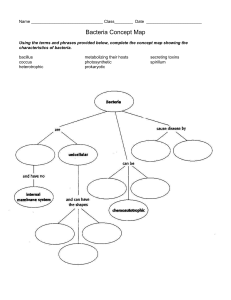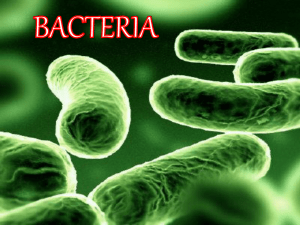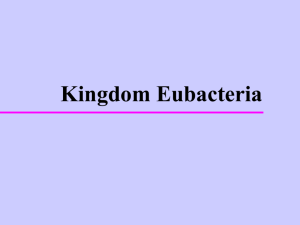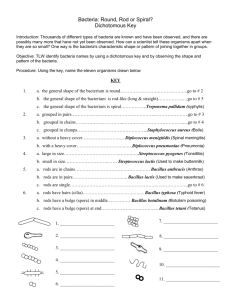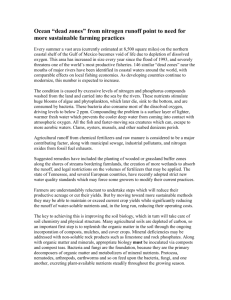Bacteria Notes
advertisement
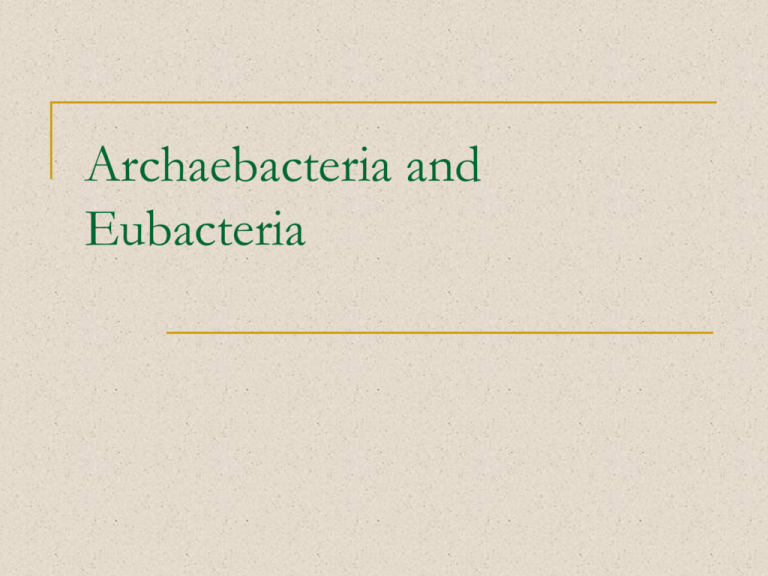
Archaebacteria and Eubacteria Archaebacteria Prokaryote Extreme habitats Marches Lake sediments Digestive tracts Sewage disposal plants Acidic Sulfur springs Ocean floor Volcanic areas Usually no free oxygen available Eubacteria Prokaryote Heterotrophic Chemosynthetic Use organic molecules as their food source Parasites – get nutrients from other organisms Saprophytes – get nutrients from dead organic matter Chemosynthesis – break down and release energy of inorganic compounds containing sulfur and nitrogen Important for converting atmospheric nitrogen into compounds for plants Photosynthetic – convert light energy into food Chlorophyll Cyanobacteria Ponds, streams, chains of independent cells http://biodidac.bio.uottawa.ca Cyanobacteria Structure of Bacteria Small ribosomes Genes in a single circular chromosome Cell Wall composed of chitin Used as weapon against antibiotics Penicillin interferes with ability to make cell walls Capsule Enhances the ability to cause disease Flagellum, Flagella Tail to help move Pillus, Pilli hairs to help stick to surfaces http://www.palaeos.com Identifying Bacteria Shapes Spheres – Coccus Rods – Bacillus Spirals - Spirillum Identifying Bacteria Shapes Spheres – coccus Rods – Bacillus Spirals - Spirillum Identifying Bacteria Shapes Spheres – coccus Rods – Bacillus Spirals - Spirillum Identifying Bacteria Coccus Growth Patterns Diplo – paired growth Stahphylo – grapes Strepto - chains Reproduction - Binary Fission Asexual Reproduction Copies chromosome Cell membrane grows separating chromosomes Partition forms and two genetically identical cells created Some produce up to once every 20 minutes Run out of space, nutrients Wastes kill them Reproduction - Conjugation Sexual Reproduction One bacterium transfers all or part of chromosome through bridge (pilus) to another New genetic compositions! http://fig.cox.miami.edu Diversity of Metabolism the set of chemical reactions that happen in the cells of living organisms to sustain life. Obligate aerobes Obligate anaerobes Require oxygen Cellular Respiration Mycobacterium tuberculosis Killed by oxygen Energy is released by fermentation Treponema pallidum - syphillis Toxins Anaerobes can produce powerful poisons Endospores Tiny structure that contains DNA, some cytoplasm, and is encased by tough covering Rests and does not reproduce Occurs when faced with unfavorable conditions Resists boiling water, outer space, dryness and harsh chemicals Bacteria Importance Nitrogen Fixation 1. N2 = 80% of atmosphere All organisms need Nitrogen Process that converts N2 into ammonia preformed by bacteria = Nitrogen fixation Ammonia Nitrite Nitrate also done by bacteria Live symbiotically with roots of trees and legumes Peas, peanuts, soybeans Bacteria Importance 2. Recycling of Nutrients Break down materials and wastes Returns nutrients to environment 3. Foods and Medicines During respiration diverse products produced Cheese, Vinegar, Vitamins, antibiotics 4. Diseases Air, food, water, wounds Interfere with body tissue or release toxins
